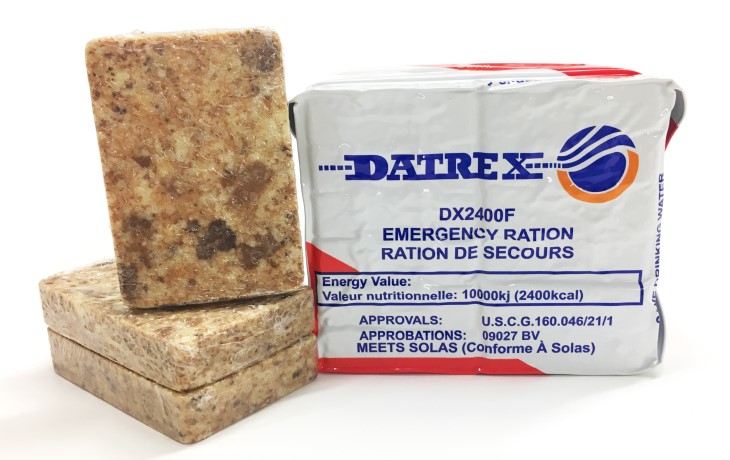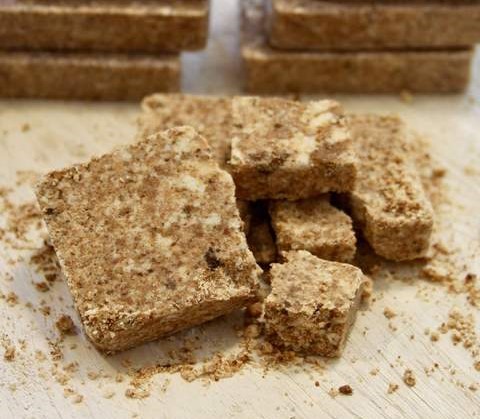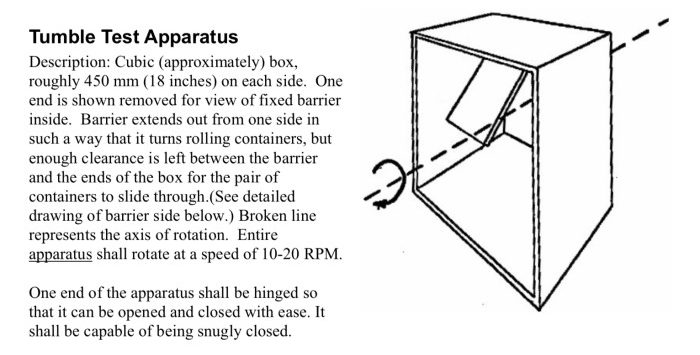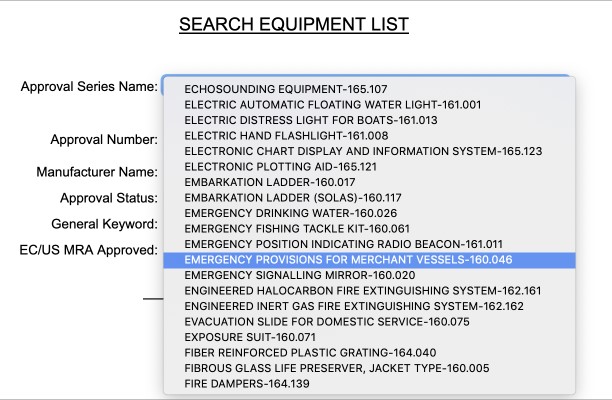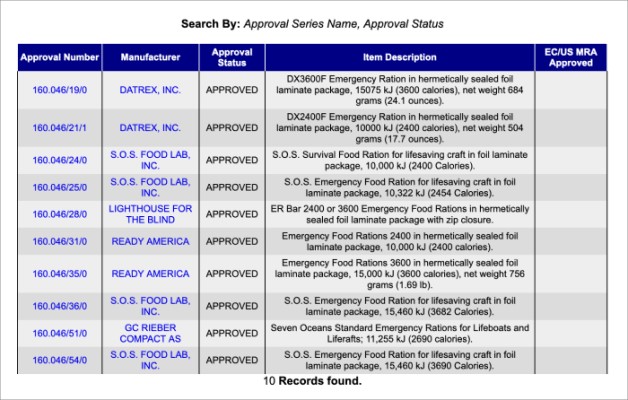Ration blocks have sturdy packaging, cram in a lot of calories and nutrients in a small package, can withstand extreme temperatures without melting, and shouldn’t make you thirsty. They have a long shelf life, usually around five years, so you can toss them in a bag and not worry about them for a long time.
That’s why this style of food bar is used for lifeboat rations. It’s easy to imagine what groups like the US Coast Guard would look for when picking the only food available in a lifeboat:
- Long shelf life. Lifeboats are rarely used, so they want to replace old gear as infrequently as possible.
- Temperature, climate, and shake resistant. Whether it’s extremely cold, the sun is beating down, or water is spraying from violent seas, delicate food won’t survive in a lifeboat during storage or after deployment.
- Same goes for durable packaging that can handle being thrown around in a storm or attacked by rodents and insects.
- Doesn’t require cooking, fresh water, or other resources. If you’re sitting in a rubber raft in the middle of the ocean, you want as few requirements as possible.
- Doesn’t make you thirsty. It’s difficult to create potable water in a lifeboat (never drink sea water), so you don’t want to make an already-dangerous situation worse.
- A lot of nutrition in a small package. Space and weight are at a premium in a lifeboat, so it makes sense to cram in as much nutrition as possible.
Those qualities are the same reason why these ration bars are a great fit in your portable go-bags and car kits. For example, it’s always a challenge keeping a little backup food in your vehicle because it can really bake when sitting in the sun. Or you might not have the time or resources to reconstitute a freeze-dried pouch.
More food guides:
- How to make hardtack or “ship’s biskit” (kind of a DIY lifeboat bar)
- What to buy from the supermarket for your at-home pantry
- Best two-week emergency survival food for preppers
- MREs
Although there’s freeze-dried survival food kits (eg. Mountain House) that are great for your home supplies, and some of those single-serving freeze-dried pouches can make sense in a go-bag, these nutritionally-dense food bars are great when you need easy, fast, and always-available calories.
The most important bits when buying ration blocks:
- Most packs are made up of 200 calorie individually-wrapped bars for a total of 2,400 or 3,600 calories. You can eat comfortably for 2-3 days (depending on exertion) or stretch it out for a week+ if needed.
- A 3,600 calorie pack is about the size of a brick. That high density means they’re heavy for their size — most people only have one pack per go-bag. 3,600-calorie packs are about half a pound heavier than 2,400 packs.
- Ration blocks are largely composed of wheat flour and sugar. Diabetics and gluten-intolerants be warned.
- The nutritional focus is on calories and carbohydrates. There’s just enough fat to make them palatable. They are not good sources of protein, fiber, or electrolytes.
- Lifeboat rations are regulated by international treaty and often approved by groups like the Coast Guard using the ‘SOLAS’ standard. Feel confident buying officially-approved items and skip the rest.
- Shelf life averages five years.
- Unlike nuts, chocolate, and other “hiker food,” ration blocks won’t melt in your bug-out bag or attract insects.
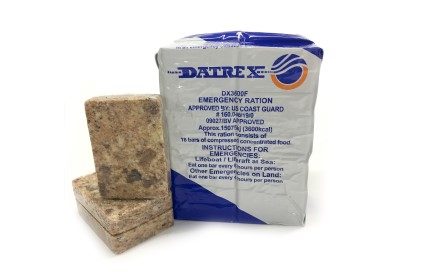
Datrex 3600
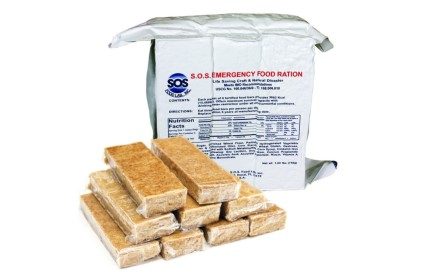
Datrex and SOS food bars are coconut flavored. It’s not a strong flavor, but if you hate coconut, consider the lemon-vanilla flavored ER Bars or the apple-cinnamon flavored Mayday bars.
Besides flavor, you wouldn’t notice much of a difference between these top contenders. Datrex comes in smaller 200-calorie servings, while SOS favors 400 per block. Price can be a little tricky to track down since some of these companies only sell in bulk to distributors / ecommerce stores (eg. Mayday), who then sell individual packs.
We recently experimented with baking ration blocks to see how they would hold up to high temperatures. We tested the Datrex and SOS bars and found that the Datrex bars held up a little better to the heat than the SOS bars, but both are great options for your go-bag or vehicle.
As of August 2022, these are the market prices, price per calorie, and overall weight:
| Product | Price | $/Calorie | Weight |
|---|---|---|---|
| Datrex 3600 Calorie | $5.95 | $0.0017 | 24.8 oz (720 g) |
| Datrex 2400 Calorie | $4.00 | $0.0017 | 17 oz (482 g) |
| SOS 3600 Calorie | $5.95 | $0.0017 | 26.6 oz (756 g) |
| SOS 2400 Calorie | $4.00 | $0.0017 | 17.7 oz (502 g) |
| ER Bar 3600 Calorie | $6.60 | $0.0018 | 27 oz (765 g) |
| ER Bar 2400 Calorie | $4.97 | $0.0021 | 18 oz (510 g) |
| Mayday 3600 Calorie | $9.75 | $0.0027 | 27 oz (756 g) |
| Mayday 2400 Calorie | $5.79 | $0.0024 | 18 oz (504 g) |
| Seven Oceans 2500 Calorie | $9.00 | $0.0036 | 18 oz (500 g) |
Be prepared. Don’t be a victim.
Want more great content and giveaways? Sign up for The Prepared’s free newsletter and get the best prepping content straight to your inbox. 1-2 emails a month, 0% spam.
Manufacturers approved by the US Coast Guard or NATO
There are four US-based brands and one from the EU, the latter of which is hard to find in the US. Some manufacturers don’t sell directly to consumers, so you have to buy from resellers instead.
- Datrex. The most recognized brand, to the point people will refer to this entire category of food as “Datrex bars.” Approved Datrex blocks are coconut flavored and come in two servings: 2,400 and 3,600 calories. US based.
- S.O.S. Food Lab. The other most-recognized brand. Coconut flavored in 2,400 and 3,600 packs. US based.
- Mayday Supplies. A brand owned by Ready America. Apple-cinnamon flavor in 2,400 and 3,600 packs.
- Quake Kare. Owned by Lighthouse for the Blind, a charity for the visually disabled. Their ERBars come in lemon-vanilla flavor with 2,400- and 3,600-calorie packs. US based.
- GC Reiber Compact. Norwegian. Their Coast Guard-approved ration, the 2500-calorie Seven Oceans Standard Emergency Ration, is unflavored. The only official distributor in the United States is Viking Life-Saving Equipment, though we also found it for sale at Life Raft + Survival Equipment.
There are makers who claim to build to “Coast Guard standards” without actually going through the independent certification process. If you want to check those out:
What are ration blocks made from?
Expect enriched bleached wheat flour or some sort of sweetener to be at the top of the ingredient list, followed by palm oil and a long list of vitamins. There are usually other miscellaneous ingredients, but these are essentially vitamin-enriched and durable blocks of sugar.
Wheat is a great survival food because it’s dense in calories and nutrients, but has a poor shelf life once it’s ground into flour. It’s bleached to remove the bran and germ that encourages spoilage. Unfortunately, that’s also where a lot of the nutrients are, so the bleached flour is enriched to add back some of those nutrients.
Palm oil is used because it is calorically dense, solid at room temperature, and makes a great food binder to hold everything together. Finally, sweeteners like sugar and corn syrup add much-needed calories and taste. It’s not health food, but it will keep you alive.
If you’re diabetic or have a severe gluten sensitivity, you might want to favor other options (like freeze-dried pouches). If you stick with ration bars, be sure to eat some before an emergency to see how you react.
Most of these blocks also contain soy, which is a concern for some. Datrex is the only ration bar we’ve seen that does not contain soy.
SOLAS and Coast Guard standards
Because ration blocks are designed with lifeboats in mind, standards are governed by maritime organizations, such as the United States Coast Guard (USCG) and the International Maritime Organization.
The International Convention for the Safety of Life at Sea (SOLAS) is an international treaty that sets standards for maritime safety, including ration blocks. The actual SOLAS requirements are rather vague:
- The rations must be palatable and edible through the expiration date.
- Rations must be packed in a manner that can be “readily divided and easily opened,” even while wearing gloves.
- Rations must be packed in “permanently sealed metal containers or vacuum packed in a flexible packaging material with a negligible vapour transmission rate.”
- If the rations are packed in the aforementioned flexible packaging material, they need to be enclosed in a sturdier outer packaging.
- “The packaging shall be clearly marked with date of packing and date of expiry, the production lot number, the content in the package and instructions for use.”
In short, this is the bare minimum you should expect from a ration bar: you can eat it, it should be sturdily packaged but accessible without much fuss, and the package needs to have a clear expiration date on the outside.
However, since SOLAS is just a treaty, it doesn’t approve of ration blocks. Here in the United States, that job falls to the Coast Guard, which has much more stringent standards and requires laboratory testing — for example, they’ll perform “tumble” tests in a lab to see if the food holds up under physical stress.
Coast Guard guidelines fall under approval series 160.046, Emergency Provisions for Merchant Vessels. The highlights:
- Ingredients should be palatable and do not provoke thirst.
- At least 25% of each ration bar unit should be able to be mixed with water and drank.
- Ration blocks should be hermetically sealed, ideally vacuum packed, and suitable for storage for up to five years in temperatures ranging from -22F to 149F.
- The facility where they are packed should be clean and sanitary.
- Ration blocks must be tested by a Coast Guard-approved independent laboratory to ensure that they meet Coast Guard standards.
Additionally, specific ingredients are of concern:
Marine survival rations are intended strictly for short-term survival situations at sea, and not necessarily as a long-term, well-balanced diet. The primary concern is to reduce water uptake, since fresh water is limited in a sea survival situation. Therefore, salt and protein content should be low. Carbohydrate provides a source of energy readily usable by the body, therefore it should be a high percentage of the provision. Since fats can contribute to rancidity, they should be limited to the amount needed for binder and palatability.
Finally, ration bar composition should look like the following:
- Moisture: No more than 3-7%
- Salt: No more than 0.2%
- Carbohydrates: 60-70% by weight or 50-60% by calories.
- Fat: 18-23% by weight or 33-43% by calories.
- Protein: 6-10% by weight or 5-8% by calories.
Salt and protein are to be kept to a minimum so as to not provoke thirst. That is crucial when bugging out, when water may be difficult to acquire. Also, fats are to be limited because they can go rancid.
How to tell if a ration bar is Coast Guard approved
- Visit the USCG Maritime Information Exchange Approved Equipment List search.
- Under Approval Series Name, choose EMERGENCY PROVISIONS FOR MERCHANT VESSELS-160.046.
- Choose APPROVED under Approval Status.
- Click or tap Search.
You’re presented with a list of ration blocks approved by the Coast Guard. Pay special attention to the approval number, which is tied to a specific product.
You can click the approval number to see more information about the vendor and what laboratory performed the testing. When you visit a ration bar vendor’s site, they should have a link to the certificate on the product page. View that certificate and ensure that the approval number on the certificate matches what is in the Coast Guard’s database.
A trick I will often do is to copy the approval number and paste it into Google. More often than not, that takes me to the correct product.
